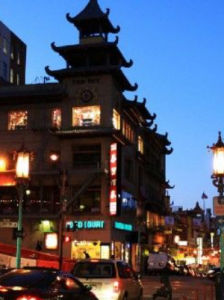世界主要唐人街列表
亞太
泰國曼谷、菲律賓馬尼拉、越南胡志明市、馬來西亞檳城、馬來西亞吉隆坡、新加坡、日本橫濱中華街、日本神戶中央區南京町、日本長崎新地、韓國首爾、韓國仁川、澳洲墨爾本、澳洲悉尼Capitol-Terrace
美洲
美國紐約 、美國舊金山 - Jackson Street, Stockton Avenue 、美國洛杉磯 - Broadway Avenue, Spring Street 、美國波士頓 、美國芝加哥 - Along Wentworth at Cermak 、美國費城 、美國波特蘭 、美國西雅圖 、美國華盛頓 - H Street 、加拿大多倫多登打士西街唐人街、加拿大多倫多華埠 - Dundas Street, Spadina Avenue 、加拿大溫哥華 - Pender Street and Main Street 、加拿大列治文 、加拿大蒙特婁-rue ST-LAURENT
歐洲
英國倫敦中國城、法國巴黎
世界次要唐人街列表
亞太緬甸仰光 、澳洲布里斯班、 紐西蘭奧克蘭Newmarket 、紐西蘭威靈頓
美洲
美國克里夫蘭 、夏威夷檀香山 、美國休士頓 、美國奧克蘭 - Broadway Avenue, 7th Street, Harrison Avenue, 10th Street 、美國奧克拉荷馬市 - N. West 23rd Street and Classen Blvd 、美國匹茲堡 、美國沙加緬度 - 3rd, 5th, J, and I Streets 、墨西哥墨西哥市 、加拿大卡爾加里 、加拿大艾德蒙頓 、加拿大溫尼伯 、古巴哈瓦那
歐洲
格拉斯哥的小型唐人街是個被稱為“中國城”的商場俄羅斯莫斯科 、英國曼徹斯特 、英國伯明罕 、英國利物浦 、英國格拉斯哥、 英國卡的夫、 荷蘭阿姆斯特丹
唐人街(又稱華埠或中國城;英語:Chinatown)是指除兩岸三地以外的其它國家大城中華裔人士聚居區。唐人街因歷史因素或特殊國情在東亞、東南亞和北美洲皆十分常見。唐人街最早在19世紀的美國和加拿大形成。當時,由於歧視性的土地法規嚴禁華人等有色人種介入土地買賣市場或僅準許華人在特定區域購買土地,從而形成了第一代華人移民的聚居區。
唐人街之形成,乃因為早期華人移居海外,成為當地的少數族群,在面對新環境需要同舟共濟,便群居在一個地帶,故此多數唐人街是華僑歷史的一種見證。在東南亞,由於移民的歷史比較早,因此語言和文化多與當地融合了。另外華裔因為力爭上遊,所以一般還掌控了當地的產業主導權,這也形成了一個有趣的普遍現象。
在北美的唐人街經常可見餐館林立,而餐館和洗衣店即早期華僑的主要營商行業。一些歷史較悠久的唐人街,皆位於大城的舊區,環境會較為擠迫,治安和種族問題亦是某一些華埠要面對的問題。一些唐人街亦出現華人人口遷離、人口老化的現象。
另一方面,隨著地球村的觀念形成,半世紀以來,各國政府紛紛開放參政權予華裔,使華人的地位在外國趨於公平,在西方國家新一代的華人移民和當地土生土長的華裔人士由於高科技、企管和專業背景,許多家庭甚至於有經濟能力在高級住宅區居住。北美洲好幾個都會區更已進入「後唐人街」時代,即唐人街外的華人人口和商業活動已遠超過原唐人街,而且華人人口和商業活動不再是聚集在某個社區,而是在市郊多個相鄰社區里,散居在主流或其他少數族裔當中。「後唐人街」的例子包括美國加州洛杉磯地區的聖蓋博谷、舊金山灣區的矽谷、紐約皇后區的法拉盛、加拿大溫哥華地區的列治文市和本那比市,以及多倫多地區的士嘉堡區、萬錦鎮等。
A Chinatown is a section of an urban area with a large number of Chinese outside the majority-Chinese countries of Greater China. Chinatowns occur all over the world, including those in East Asia, Southeast Asia, North America, South America, Australia, Europe and the United Kingdom.
In the past, overcrowded Chinatowns in urban areas were generally shunned by the non-Chinese public as ethnic ghettos, and seen as places of vice and cultural insularity where "unassimilable foreigners" congregated. Nowadays, many old and new Chinatowns are considered significant centers of commercialism and tourism. Some of them also serve, to varying degrees, as centers of multiculturalism, if in a somewhat superficial manner.
Many Chinatowns are focused on commercial tourism, whereas others are actual living and working communities; some are a synthesis of both. Chinatowns also range from rundown ghettos to modern sites of recent development. In some, recent investments have revitalized run-down and blighted areas and turned them into centers of economic and social activity. In certain cases, this has led to gentrification and a reduction in the specifically Chinese character of the neighborhoods.
Chinatowns have a long history, such as the Chinatown in Nagasaki, Japan, or Yaowarat Road in Bangkok, both of which were founded by Chinese traders more than 200 years ago. Chinatown, San Francisco, California was the first Chinatown to be established outside Asia, during the California Gold Rush, which began in 1848. Other cities in North America where Chinatowns were established in the mid-nineteenth century include almost every major settlement along the West Coast from San Diego to Victoria BC and Vancouver BC. The British Columbia Chinatowns played major roles, as ports of entry, in the Klondike Gold Rush and Caribou Gold Rush. By the second half of the nineteenth century, bustling Chinatowns were also established in New York and Chicago. The discovery of gold Australia caused the establishment of relatively small Chinatowns in cities there, and similar migrations of Chinese resulted in tiny settlements termed "Chinatowns" being established in New Zealand and even South Africa. European Chinatowns, such as those in Germany, the Netherlands, and the United Kingdom, are for the most part smaller and more recent than North American Chinatowns. Other Chinatowns are newer, such as in Chinatown, Las Vegas in 1995, Dubai, and Santo Domingo and have received official recognition.

